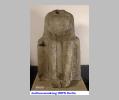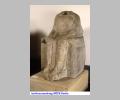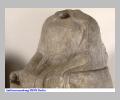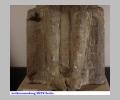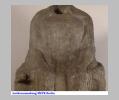| Collection: | Berlin, Antikenmuseen |
| Title: | Seated Woman from Miletus |
| Context: | From Miletus |
| Findspot: | Excavated at Miletus, in a Roman wall together with a second statue ( |
| Summary: | Woman seated in high-back chair |
| Object Function: | Funerary? |
| Material: | Marble |
| Sculpture Type: | Free-standing statue: kore |
| Category: | Statuary group |
| Style: | High Archaic |
| Technique: | In-the-round |
| Original or Copy: | Original |
| Date: | ca. 550 BC - ca. 525 BC |
| Dimensions: | H. 0.92 m, W. 0.54 m, D. 0.63 m |
| Scale: | Life-size |
| Region: | Ionia |
| Period: | High Archaic |
| In Group: | Seated women from Miletos |
Subject Description:
Seated female statue dressed in the standard East Greek combination of chiton, short Ionic himation and epiblema. The chiton is visible in the narrow arched band of wavy folds over the center of the belt which represents the kolpos and the lower part of the garment which covers the legs. As is typical of these seated statues, most of the fabric of the lower portion is gathered between the legs where it forms a thick stack of folds beneath the paraphe, originally decorated with paint. In this statue the stack is indicated only by the thickness of the fabric and not by the individual representation of the ends of folds between the feet, as is sometimes the case. The chiton rests high on the ankles and forms a single deep dip between the protruding feet. The feet themselves are supported on a rounded footrest. Over the chiton the woman wears a short himation, buttoned over the right arm. This garment is distinguished by closely grouped collections of folds which begin at the buttons and fan out in a left to right direction (i.e. from the proper right shoulder across the full width of the chest), then fall vertically from the breasts. On the left arm it forms a kind of overlapping sleeve. The epiblema, which was draped over the separately-carved (and now missing) head, falls in a lappet-like arrangement over the front of the shoulders in what was apparently a Milesian fashion, before continuing down the back.
The high-backed chair, massive in form, is nonetheless distinguished by its various elements. The arms are clearly rounded and end in bosses at the front, the softness of the cushion is shown by a more subtle rounding, and the seat and legs are indicated, at least on the sides. On the front, very roughly scratched, are the letters
Form & Style: The treatment of the folds of the himation, which form a continuous curve from the right shoulder over the breasts (rather than a more rigidly diagonal or horizontal-to-vertical pattern), is a development which seems to occur after the middle of the 6th century. The greater emphasis on the vertical portion of the folds, the variation in their widths and the symmetrical stacking of their edges from the center out are also indications of a more advanced stage of development than is typical of many of the Branchidae statues from Didyma, perhaps a quarter century earlier. The modeling of the folds of the kolpos coincides with this stage of development as well. On the other hand, the exaggerated attenuation of the hands and feet, the four-squareness of the figure and the way in which the himation fully covers the chest (rather than passing beneath the left arm) suggests that the statue was carved sometime during the third quarter of the century rather than much later.
Condition: Intact
Condition Description: Seated statue carved in one piece with the chair. Only the head is lacking, which was carved separately with the neck and set into the shoulders. Heavily weathered, with damage due to weathering especially prominent on the forearms, hands and feet.
Material Description: Grayish white, large-grained marble
Sources Used:
